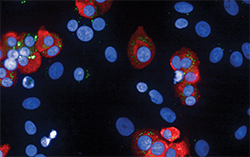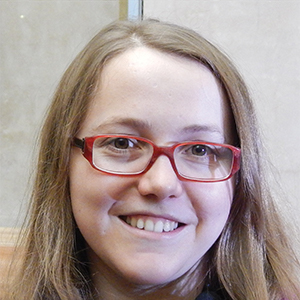From the journals: October 2018
We offer a selection of recent papers on a variety of topics from the Journal of Biological Chemistry, the Journal of Lipid Research and Molecular & Cellular Proteomics.
Risks on risks: how genes interact to influence Type 2 diabetes
 Human beta cells and insulin granules.Courtesy of Wikimanji/Wikimedia Commons Researchers at Imperial College London, publishing in the Journal of Biological Chemistry, have found that the same gene can have opposite effects on Type 2 diabetes risk depending on what’s going on elsewhere in the genome.
Human beta cells and insulin granules.Courtesy of Wikimanji/Wikimedia Commons Researchers at Imperial College London, publishing in the Journal of Biological Chemistry, have found that the same gene can have opposite effects on Type 2 diabetes risk depending on what’s going on elsewhere in the genome.
Massive genomewide association studies have shown that individuals carrying a particular variant of the gene transcription factor 7-like 2, or TCF7L2, have a greater risk of developing Type 2 diabetes.
Guy Rutter’s team at Imperial College previously had shown that knocking out the TCF7L2 gene in the pancreatic beta cells in mice caused the cells to secrete less insulin. But the team suspected that this was an oversimplification compared to how Type 2 diabetes works outside the laboratory.
“There are subtypes of Type 2 diabetes, four different types, which are distinguished by the severity of the disease, when it happens in life, whether you are overweight or lean, and so forth,” Rutter said. “And it turns out that the impact of the genetic variant in (TCF7L2) differs when you’re in different subgroups.”
The team decided to investigate whether there were other genes that modified how much of an effect TCF7L2 would have. They produced knockout mice characterized by overproliferating beta cells. Then they further knocked out TCF7L2 in these mice.
To their surprise, knocking out TCF7L2 in this mouse model had the opposite effect on insulin secretion compared to its effect in standard mice. That is, when mice had an overproliferation of beta cells, the absence of TCF7L2 caused those beta cells to produce more insulin, not less.
There are many conditions in humans that can lead to a similar proliferation of beta cells, such as pregnancy, prediabetic conditions or the presence of certain genetic variants. This means that knowing what variant of TCF7L2 an individual has isn’t the whole story; how TCF7L2 affects diabetes risk also depends on other factors.
“This is important information if we are to use risk genes as clinically useful predictors of who will develop the disease and who won’t,” Rutter said.
— Sasha Mushegian
Restoring balance in cystic fibrosis
Cystic fibrosis sometimes is characterized as a disease of protease-antiprotease imbalance. Apparao Kummarapurugu and colleagues at Virginia Commonwealth University examined whether using heparin to inhibit the protease neutrophil elastase, or NE, could restore this balance. They found that heparins inhibited NE in the presence of dornase, a drug used in cystic fibrosis patients to reduce sputum viscosity. Further studies suggested that heparin bound NE more potently than other NE ligands, suggesting that it can be developed further as an antiprotease therapy. The results were published in the Journal of Biological Chemistry.
Adventures in influenza
Perhaps inspired by the annual 3 to 5 million cases of severe influenza worldwide, the Guinness World Record organization is advertising for individuals or organizations to attempt a record for the most people getting a flu awareness lesson at once. Meanwhile, a smaller group of people is making a more focused attempt to learn about lots of flu proteins. Andrea C. Becker at the University of Freiburg and her colleagues in Germany and Switzerland investigated the effect of the flu-causing virus influenza A on three lung-derived cell lines and published their results in the journal Molecular & Cellular Proteomics.
The study quantified virus-induced changes in protein levels and found that a majority of the changes are cell-line specific. More specifically, they quantified the protein levels of 70 percent of the roughly 7,000 proteins they could detect using a mass spectrometry-based isotope labeling approach known as SILAC. Influenza infection of lung cells changed the overall abundance of only a few proteins, mostly related to immunity, but SILAC comparisons showed that the virus changes the cellular location of many proteins. In particular, the authors detected an increase in viral and ribosomal proteins in the autophagosome, which they linked to a reduction in successful autophagy, suggesting that the virus may hijack autophagosomes, perhaps using the compartments for viral protein translation.
Stinginess with zinc aids resistance
Beta-lactam antibiotics like penicillin are among the first-line drugs for infections, but many bacteria express beta-lactamase enzymes that enable bacteria to resist beta-lactam antibiotics. A special class of these enzymes called metallo-beta-lactamases additionally are resistant to beta-lactamase inhibitors used in combination therapies. In a paper in the Journal of Biological Chemistry, Zishuo Cheng and colleagues at Miami University describe how they examined the structure and function of clinical variants of metallo-beta-lactamases. They found that structure, stability and function of these enzymes were critically affected by zinc availability and that some variants have evolved to function with one, rather than two, zinc ions.
Rods, cones and fatty acids
Photoreceptors in the eye come in two main flavors, rods and cones. Rods are used for vision at low light and cones for color and bright light. Certain animals can be cone or rod dominant. For example, the tree squirrel and tree shrew have higher levels of cone receptors and are better adapted to bright light. All these photoreceptors use molecules called polyunsaturated fatty acids, or PUFAs, during retinal development, and PUFA synthesis is dysregulated in the cone receptors during diseases such as Startgardt-like macular dystrophy. To study the PUFAs’ role in cone receptors, Martin-Paul G. Agbaba and colleagues of the University of Oklahoma Health Sciences Center examined PUFA levels using animals with a majority of cone receptors either naturally occurring or through genetic manipulation. Under normal circumstances, researchers found that cone-dominant animals have surprisingly low levels of PUFA precursors and products. This suggests that different lipids are important for cone receptors, as healthy rod receptors have higher PUFA levels yet are unaffected in the Startgardt-like macular dystrophy. While rods and cone photoreceptors work together to achieve vision, they are fine-tuned differently to allow this to occur. This study was published in the Journal of Lipid Research.
Deadly cooperation in glioblastoma
 This MRI sagittal view shows a grade IV glioblastoma in a 15-year-old boy.Courtesy of Christaras A/Wikimedia Commons U.S. Sens. John McCain of Arizona and Ted Kennedy of Massachusetts died exactly nine years apart, both after battling glioblastoma multiforme, or GBM. GBM is a rare and highly aggressive brain cancer that occurs mainly in older adults. Between 40 percent and 70 percent of patients with this disease have altered signaling through the epidermal growth factor receptor, or EGFR.
This MRI sagittal view shows a grade IV glioblastoma in a 15-year-old boy.Courtesy of Christaras A/Wikimedia Commons U.S. Sens. John McCain of Arizona and Ted Kennedy of Massachusetts died exactly nine years apart, both after battling glioblastoma multiforme, or GBM. GBM is a rare and highly aggressive brain cancer that occurs mainly in older adults. Between 40 percent and 70 percent of patients with this disease have altered signaling through the epidermal growth factor receptor, or EGFR.
In a study published in Molecular & Cellular Proteomics, Dongsic Choi of McGill University in Canada and colleagues describe the effects of one frequently observed tumor-causing variant, called EGFRvIII, on the protein composition of extracellular vesicles, or EVs, secreted by GMB cells. These small bilayer vesicles containing lipids, proteins and nucleic acids are secreted from cells and can stimulate physiologic processes in the surrounding environment, such as cell migration and blood vessel formation. Cancer cells use EVs in many diverse processes. For example, EGFvIII mRNA and protein can be a cargo in GBM-derived EVs that are taken up by surrounding cells. The presence of EGFvIII makes tumor cells more migratory and aggressive, which contributes to cancer metastasis.
Using quantitative proteomics, the researchers found that expression of EGFRvIII in tumor cells significantly increases the levels of invasion-promoting proteins in the cargo of the EVs and that the presence of EGFRvIII in cells promotes uptake of EV from other cells. This study refines current understanding of glioblastoma mechanisms and may offer new opportunities for biomarker development and future therapies.
— Nathalie Gerassimov
When synonymous substitutions aren’t
The nucleic acid code has some redundancies built in: multiple trinucleotides, called synonymous codons, can code for the same amino acid. However, it’s increasingly recognized that even if two codons encode the same amino acid, there can be subtly different consequences for using one or the other. Alexander Bertalovitz and colleagues at the University of South Florida examined synonymous nucleotide substitutions in the gene that encodes the hERG ion channel, which contributes to regulating heartbeats. They found that, depending on the codons used, the levels of hERG mRNA and protein expressed differed. Thus the search for hERG mutations that affect heart disease should be expanded to include seemingly synonymous substitutions. The research was published in the Journal of Biological Chemistry.
New tool to study protein–protein interaction
Science demands evidence to support truth, and science is often limited by technology. Therefore technical innovation is a major driving force for discovery. Payman Samavarchi-Tehrani of the Lunenfeld-Tanenbaum Research Institute, Canada, and her colleagues in Anne-Claude Gingras’ lab describe an improvement to a tool used to study protein–protein interactions in a subcellular context. Specifically, they adapt methods for enzymatic biotinylation — addition of a chemical group called biotin — to be more useful in disease-relevant cell types. They write about this work in Molecular & Cellular Proteomics. Existing methods rely on cell lines into which the enzyme used for labeling attached to a protein of interest can be introduced (transfected) easily. These cells tend to be immortalized or cancer-derived cells, which may have other proteomic changes. Now researchers can use primary cells — or cells recently derived from an organism with a limited life span — to perform the same types of experiments. The researchers developed a set of lentiviral vectors that harbor the biotinylation enzyme, and these can be requested by other researchers.
Flood alarms in plants
In response to flooding, plants upregulate genes involved in tolerance of low-oxygen conditions. This response is mediated by transcriptional activators called group VII ethylene response factors, which are degraded once oxygen conditions return to normal. How these factors sense oxygen conditions is poorly understood. Mark D. White and colleagues at the University of Oxford showed that plant cysteine oxidases, which oxidize ethylene response factors and lead to their degradation, might act as these crucial oxygen sensors, because their activity was rate-limited by oxygen availability in a physiologically relevant range. The study was published in the Journal of Biological Chemistry.
Stopping cardiovascular disease with citrus
 Citrus flavonoids, which are found in grapefruit and oranges, were used in mice to reverse obesity induced by a high-fat diet.Courtesy of raeky/Wikimedia CommonsObesity and its associated diseases, such as type 2 diabetes, atherosclerosis and metabolic dysfunction, are a worldwide health issue. Many therapies have harmful side effects, result in weight regain or, in the case of gastric bypass surgery, are limited to patients with a high body mass index. Amy C. Burke and colleagues at the University of Western Ontario recently published a study in the Journal of Lipid Research using a mouse model of obesity to test how citrus flavonoids, plant compounds found in grapefruit and oranges, could intervene.
Citrus flavonoids, which are found in grapefruit and oranges, were used in mice to reverse obesity induced by a high-fat diet.Courtesy of raeky/Wikimedia CommonsObesity and its associated diseases, such as type 2 diabetes, atherosclerosis and metabolic dysfunction, are a worldwide health issue. Many therapies have harmful side effects, result in weight regain or, in the case of gastric bypass surgery, are limited to patients with a high body mass index. Amy C. Burke and colleagues at the University of Western Ontario recently published a study in the Journal of Lipid Research using a mouse model of obesity to test how citrus flavonoids, plant compounds found in grapefruit and oranges, could intervene.
While previous studies looked at preventing obesity in mice with flavonoids, Burke and colleagues aimed to reverse obesity. They compared mice on a high-fat, high-cholesterol diet with a high-cholesterol genetic background in two sets, one with normal chow meal replacement and a second with the addition of a flavonoid, after 12 weeks. While complete diet replacement reversed much of the metabolic dysfunction, flavonoid intervention with the high-fat diet had a similar effect. The mice given flavonoids lost weight and had lowered inflammation, enhanced insulin sensitivity and aortic plaque composition changes while still on the HFHC diet.
The authors point out that such treatment in humans has mixed results due to variations in metabolism and low bioavailability, but this study demonstrates how intervention, even while eating an unhealthy diet, can reverse symptoms associated with cardiovascular disease.
— Dawn Hayward
When HDL is lowered, the brain suffers
Inflammation in key areas of the brain is seen as an early step before weight gain occurs in people who consume excess calories. To probe this connection, Anna Götz and colleagues at the German Research Center for Environmental Health lowered the levels of high-density lipoprotein, or HDL, known as “good cholesterol,” in a mouse model by knocking out apolipoprotein A1, which is critical for HDL formation. They then examined whether this change caused neuronal inflammation and other metabolic dysfunctionalities. In a paper published in the Journal of Lipid Research, the researchers report that astrogliosis, the pro-inflammatory process in which neuronal astrocytes abnormally increase, was higher in the mice with lowered HDL levels. In addition, mitochondrial function was compromised in these mice, even when they were fed a low-fat diet. Treatment with HDL to restore normal levels reduced fat accumulation and alleviated the inflammation. Researchers hope that use of HDL could reverse the early brain damage that follows increased caloric intake before weight gain occurs.
CRISPR/Cas9 is right on target
Developing CRISPR/Cas9-based gene editing for clinical applications requires a thorough understanding of off-target mutations. In a paper in the Journal of Biological Chemistry, Shuang Wang and colleagues at the Kunming University of Science and Technology describe how they studied a rhesus monkey model of Duchenne muscular dystrophy, or DMD, produced using CRISPR/Cas9. Whole-genome sequencing of DMD monkeys and wild-type controls showed that, besides the one- or two-base-pair deletions that caused the DMD phenotype, there were no other mutations in functional genes, suggesting that there are no off-target effects of CRISPR/Cas9 editing in this system.
Immune role of choline metabolism
Phospholipid metabolism in the cells of the innate immune system is not well understood. Shayne Snider and colleagues at the University of Ottawa examined the role of choline, an essential nutrient for the synthesis of phosphatidylcholine, in macrophage function. They found that choline uptake and phosphatidylcholine synthesis increased when macrophages were stimulated with pro-inflammatory signals, and that choline uptake inhibition changed the makeup of secreted cytokines. Thus choline metabolism may have an unappreciated importance in immune responses. The study was published in the Journal of Biological Chemistry.
Mitochondrial protein stress responses
In addition to having their own genome, mitochondria have their own protein quality control system for maintaining the function of mitochondrially encoded proteins under stress. Anne Wilkening and colleagues at the University of Bonn investigated the effect of physiological heat stress on mitochondrial proteins from HeLa cells. They found that a mitochondrial translation elongation factor aggregated and lost solubility under even mild heat stress. In a paper published in the Journal of Biological Chemistry, the authors propose that inactivation of the elongation factor may prevent accumulation of misfolded proteins in mitochondria under stressful conditions.
Enjoy reading ASBMB Today?
Become a member to receive the print edition four times a year and the digital edition monthly.
Learn moreGet the latest from ASBMB Today
Enter your email address, and we’ll send you a weekly email with recent articles, interviews and more.
Latest in Science
Science highlights or most popular articles

Bacteriophage protein could make queso fresco safer
Researchers characterized the structure and function of PlyP100, a bacteriophage protein that shows promise as a food-safe antimicrobial for preventing Listeria monocytogenes growth in fresh cheeses.

Building the blueprint to block HIV
Wesley Sundquist will present his work on the HIV capsid and revolutionary drug, Lenacapavir, at the ASBMB Annual Meeting, March 7–10, in Maryland.

Gut microbes hijack cancer pathway in high-fat diets
Researchers at the Feinstein Institutes for Medical Research found that a high-fat diet increases ammonia-producing bacteria in the gut microbiome of mice, which in turn disrupts TGF-β signaling and promotes colorectal cancer.

Mapping fentanyl’s cellular footprint
Using a new imaging method, researchers at State University of New York at Buffalo traced fentanyl’s effects inside brain immune cells, revealing how the drug alters lipid droplets, pointing to new paths for addiction diagnostics.

Designing life’s building blocks with AI
Tanja Kortemme, a professor at the University of California, San Francisco, will discuss her research using computational biology to engineer proteins at the 2026 ASBMB Annual Meeting.

Cholesterol as a novel biomarker for Fragile X syndrome
Researchers in Quebec identified lower levels of a brain cholesterol metabolite, 24-hydroxycholesterol, in patients with fragile X syndrome, a finding that could provide a simple blood-based biomarker for understanding and managing the condition.



.jpg?lang=en-US&width=300&height=300&ext=.jpg)